HoloBuilder SpotWalk
Automating progress documentation with the Spot robot on construction sites around the world.
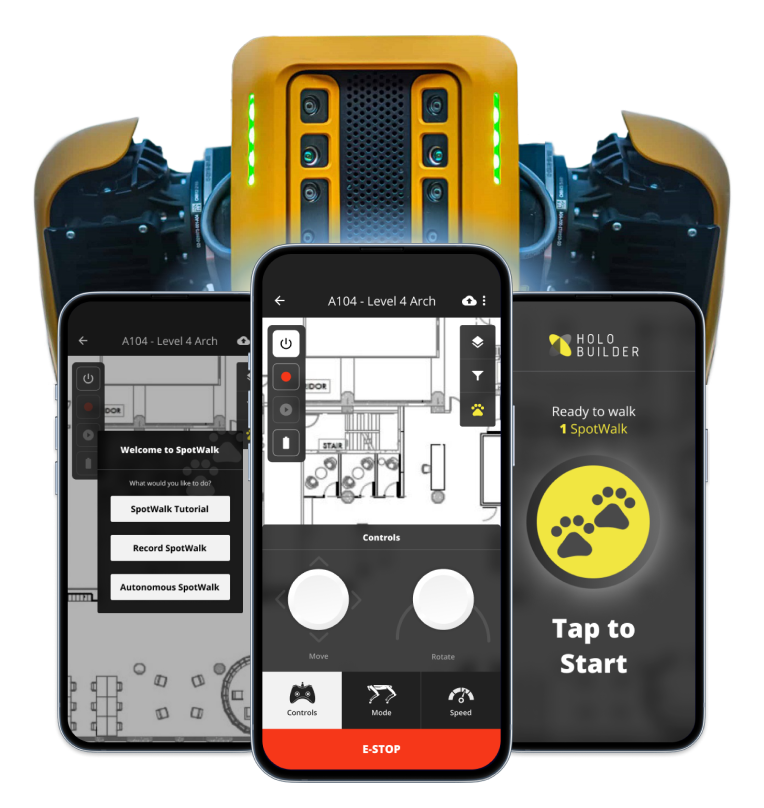
HoloBuilder SpotWalk
Automating progress documentation with the Spot robot on construction sites around the world.
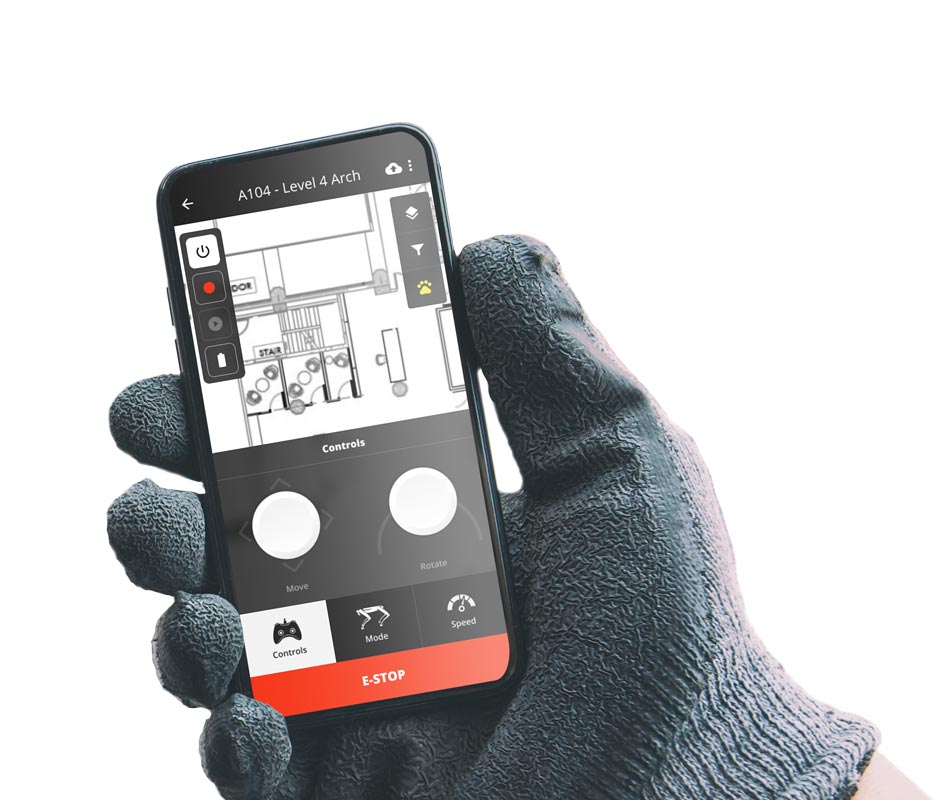
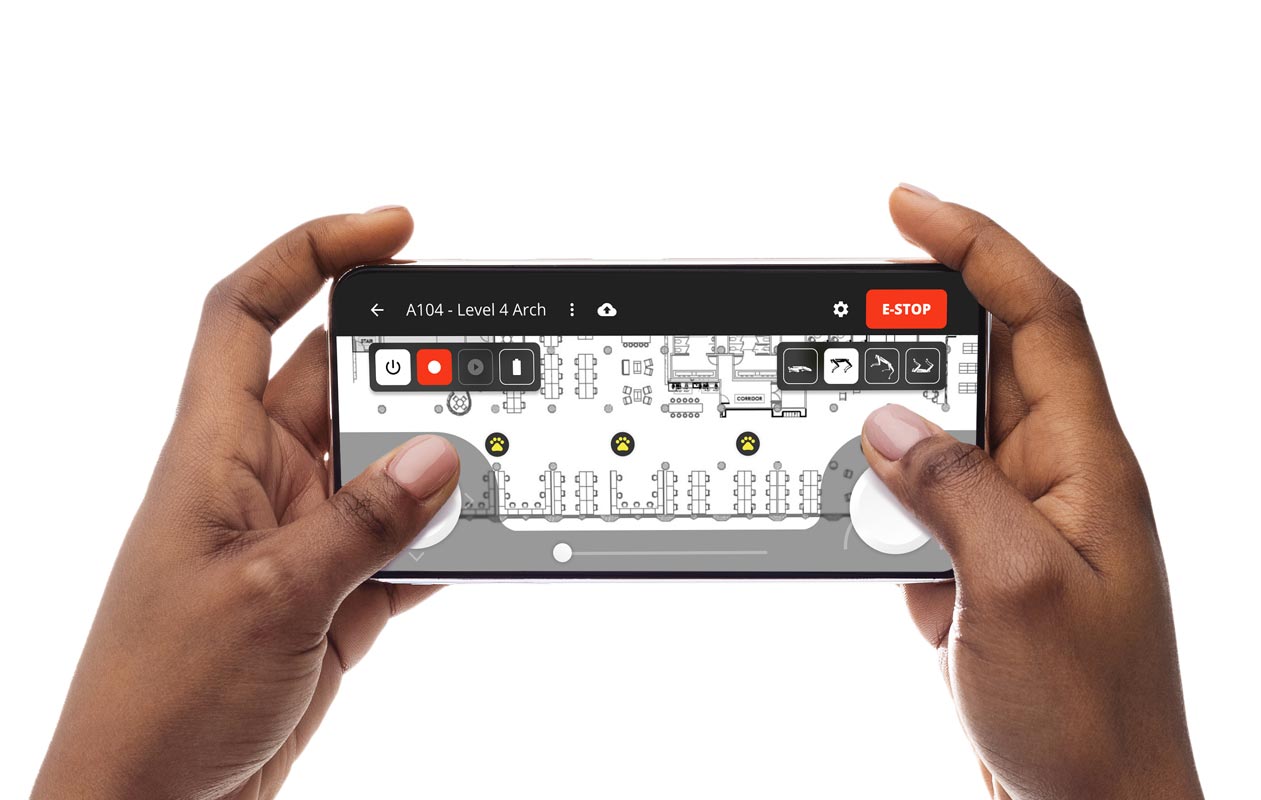
01. Overview
Automating progress documentation
background
SpotWalk is a feature In 2019, HoloBuilder announced their partnership with Boston Dynamics and released SpotWalk, a new product integration with Boston Dynamics’ Spot robot. The integration brings autonomous 360° reality capture to construction projects, addressing core productivity (photo documentation) inefficiencies that continue hampering the construction industry. I was given three weeks to design the MVP for this integration, which would be limited to only a few highly invested customers. There weren’t really any instances of robotics being used on job sites, so I felt as if I had to start from scratch on a subject that I knew nothing about…and it was exciting!
problem
Construction companies are spending too many resources on the photo documentation processes of their projects.
objectives
●
Design a MVP mobile solution that helps users utilize the Spot robot to reduce time spent on onsite photo documentation responsibilities.
results
●
75% reduction in time allocated to photo documentation processes.
●
100% conversion rate on enterprise deals for customers in the pilot program.
tools
Figma & Zoom
project Type
End-to-end
role
UX/UI Design & Visual Design
duration
3 Weeks
02. Research & Discovery
Formulating a plan
Research is a very important first step of every project, no matter how much time you have. It enables me to understand the frustrations, hopes, fears, abilities, limitations, reasoning, and goals of my users.
Due to scheduling constraints and the unknown nature of robotics on job sites, I wanted to focus the majority of my research efforts on user testing. To ensure the research stays on track, it was important to create a research plan before diving into the research phase. Listed below are the research goals, questions, assumptions and methodologies that I used for this project:
Due to scheduling constraints and the unknown nature of robotics on job sites, I wanted to focus the majority of my research efforts on user testing. To ensure the research stays on track, it was important to create a research plan before diving into the research phase. Listed below are the research goals, questions, assumptions and methodologies that I used for this project:
goals
●
Understand primary functionality that users needs.
●
Define the pros and cons of similar workflows in today’s market.
●
Learn about inefficiencies that users are currently experiencing with HoloBuilder.
assumptions
●
Primary users will be the same people who capture the site today (mostly younger field engineers).
●
Users will need to perform multiple walks per floor at some point throughout the project.
●
Users will be anxious to work with Spot.
●
Adoption will be quick.
Questions
●
Who captures the job site?
●
How long does it take to capture the job site on average?
●
How often do you capture the job site?
●
What difficulties arise while capturing the job site?
●
Do you normally capture an entire floor plan at a time?
methodologies
●
Archetypes
●
Comparative analysis
●
User-needs statements
Archetypes
For this project, I personally prefer to use archetypes instead of personas to convey the target users. This helps to remove any biases when we think about who we are designing for. If variables such as demographic and age are not necessary components in the makeup of the design, I would prefer to keep them out of the equation all together.

Field Engineer
Field engineers oversee on-site activities, ensuring that projects are executed efficiently, safely, and in compliance project plans and specifications. Their actions are integral to the daily execution of the project.
responsibilities
●
Construction execution
●
Health and safety compliance
●
Schedule adherence
●
Project documentation
●
Onsite problem solving
●
Quality control

Supervisor
Supervisors have a multifaceted role, overseeing various aspects of construction sites to ensure they are completed safely, efficiently, and in compliance with the project plans and specifications.
responsibilities
●
Personnel management
●
Regulatory compliance
●
Safety management
●
Day-today project oversight
●
Resource allocation management
●
Quality assurance

Project Manager
Project managers play a pivotal role in navigating the complexities of construction projects, ensuring that they are completed on time, within budget, and to the satisfaction of all stakeholders involved.
responsibilities
●
Project planning
●
Cost and time management
●
Quality assurance
●
Stakeholder satisfaction
●
Health, safety, and environmental compliance
How might we get a technology-deficient industry to adopt the value of using robotics onsite?
Comparative analysis
One of the project requirements that excited me most was that users would need to manually control Spot via our mobile app. Imagining the concept of this feature immediately made me think of toys such as video games, remote control cars and drones. I decided to focus on drones (specifically DJI) as those had the most overlap in terms of functionality and were already being used for photo/video capture outside of the construction industry.
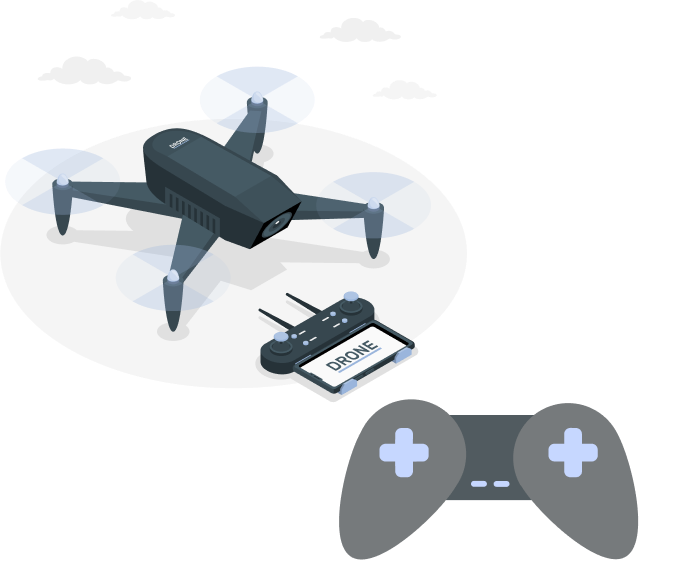
Spot has similar controls and functionality to drones and video game controllers.
key takeaways
●
Belief that drones are not risky, but safety is a slight concern.
●
A standardized set of core functions using common terminology is ideal for drone interfaces.
●
One of the most common ways to control and navigate drones is using a radio-control system, but one of the most effective ways is autopilot.
●
The variable that had the greatest influence on drone use and purchase was the user interface. Therefore, we can increase the intention to use and purchase Spot robots by focusing on maximizing the user experience of its controls.
User-needs statements
To help understand and prioritize our users' wants, needs, and pain points, I developed a set of user-needs statements to succinctly compartmentalize and communicate problems that I want to be mindful of as I design a solution for our users.
Documenting these statements in JIRA allow for team members or other internal stakeholders with interest in the project to quickly understand the reasoning behind features and functionality included outside of the initial project scope.
.svg)
"Time and accuracy are two things that are very important to a job site. Traditionally, you would have to sacrifice time out of a busy day to harvest job site pictures and organize them."
— Andrew Cameron, Project Manager at Hensel Phelps
●
As a field manager, I need to easily enable Spot to capture photos along a custom route on my job site, so that I can spend less time on the photo documentation responsibilities of my job and focus on tings that I deem more important.
●
As a supervisor, I need to ensure that my team is safely using Spot onsite, so that we remain in compliance with our safety guidelines.
●
As a project manager, I want the photos from Spot uploaded directly to our HoloBuilder project, so that we can completely take advantage of the time savings that Spot provides.
Examples of my user-needs statements
Product goals
business goals
●
Strengthen/develop relationships with partnering companies.
●
Boost standing in the construction market with an exclusive feature.
●
Incentivize enterprise deals.
●
Increase productivity in the construction industry.
product goals
●
Develop an autonomous photo documentation solution to improve productivity and efficiency.
●
Boost market standing with announcement of advanced robotics into the industry.
●
Gain competitive advantage in contech market.
user goals
●
Optimize productivity and efficiency to save time and money.
●
Automate photo documentation process.
●
Gain competitive advantage to win bids.
●
Update technology of company tools.
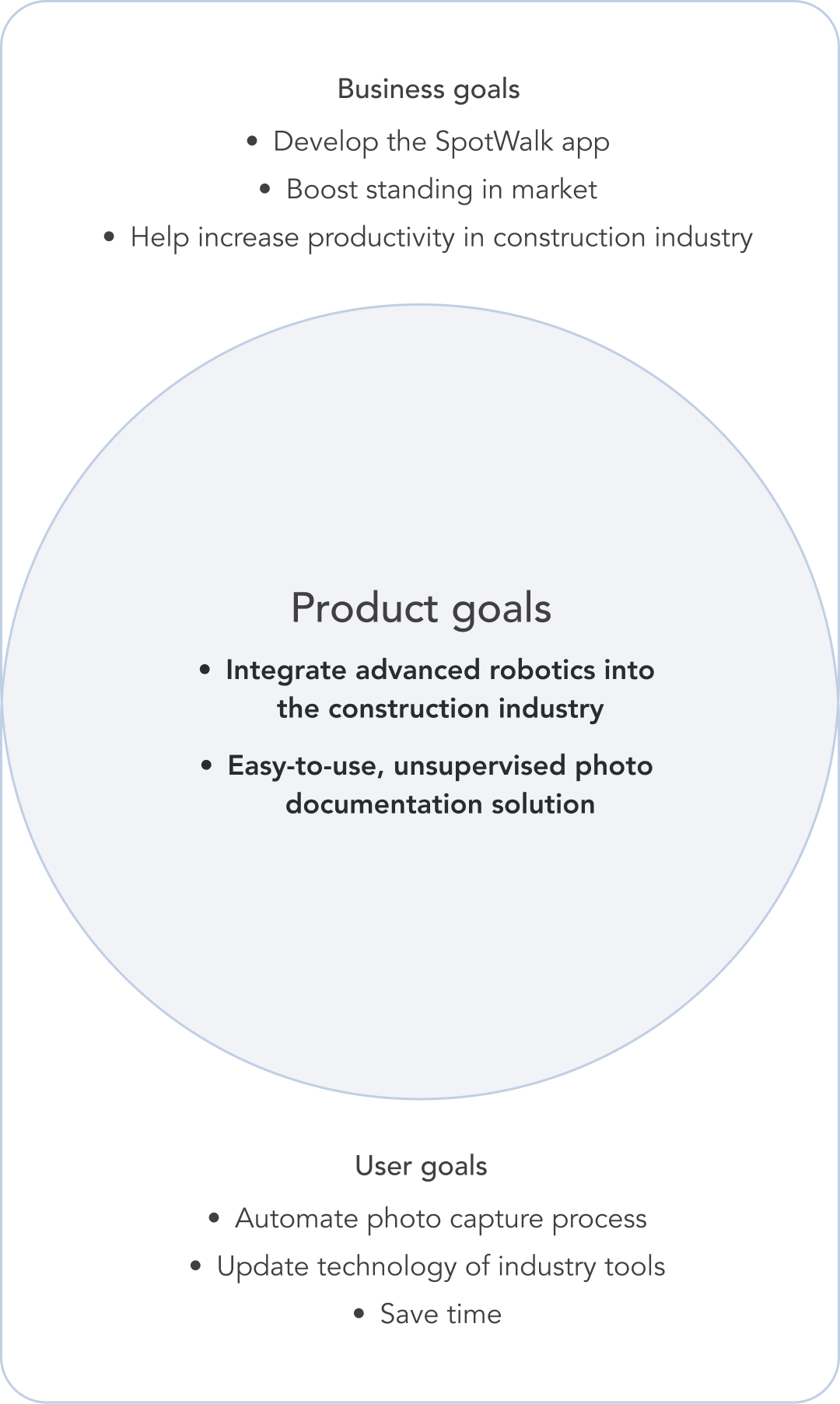
What's feasible?
Given the 3-week timeline, the team agreed upon developing a MVP (minimal viable product) that focused on our users' top needs and the most critical functionality:
must-have functionality
01.
Ability to plan a path and save it.
02.
Ability to rerun a saved path (autonomous walk).
03.
Prioritize safety by providing an emergency shut down option.
03. Design
User flow map
Now that I have a pretty good idea of what I'm designing and who I'm designing it for, it's time to begin applying the designs into our existing UI and workflows. This MVP will focus on cementing the basics for documenting a job site with Spot, which understanding that there will be more complex interactions in future iterations of the application.
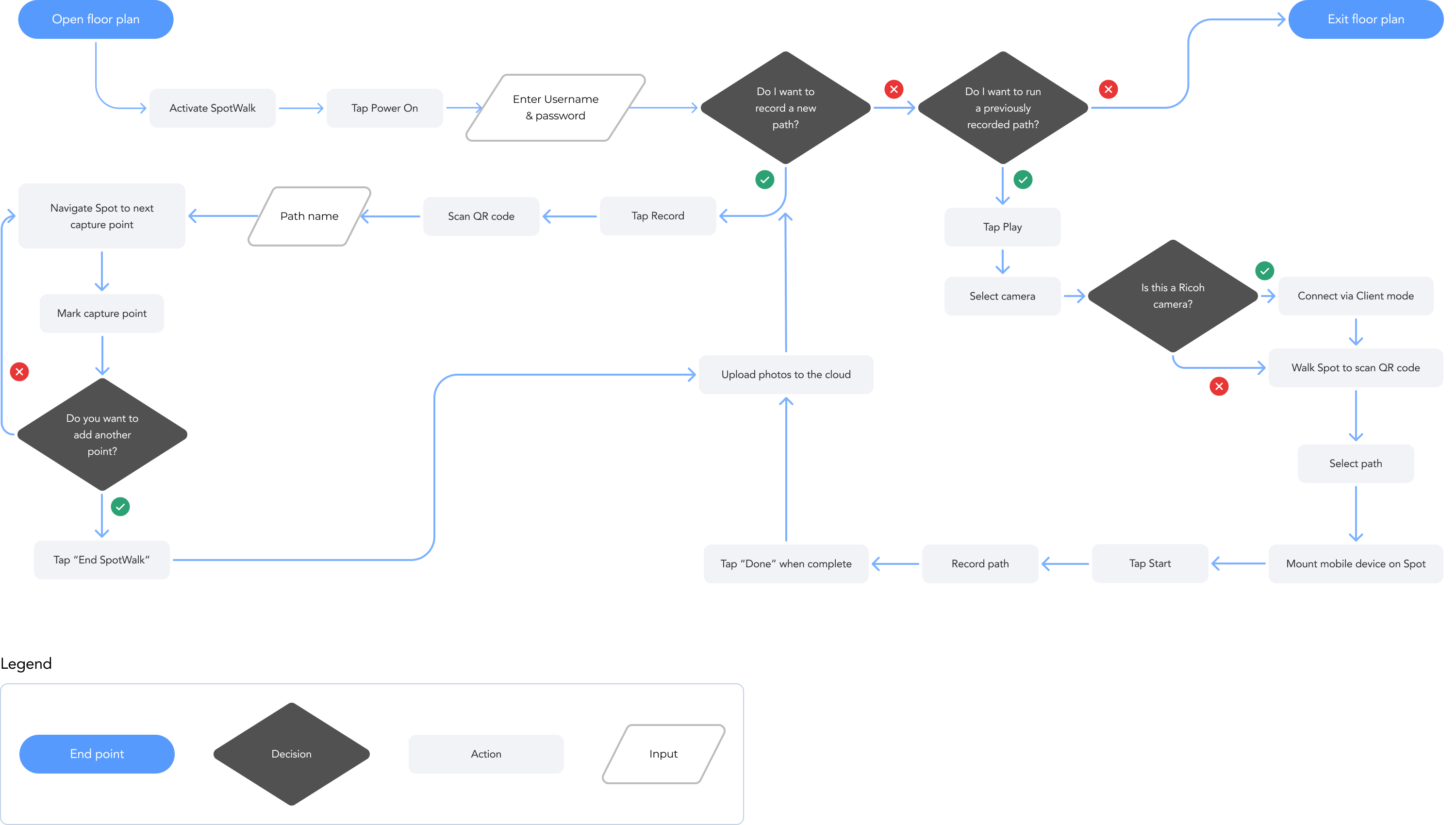
Scenario: User runs an autonomous SpotWalk to capture photos on a floor plan.
Wireframes
I began by quickly sketching some screens to incorporate the feature into our existing UI. For purposes of scalability and consistency, we wanted to utilize as much existing UI and as many existing workflows as possible. I shared these sketches with the Engineering team just to confirm that the concept was on the right track.
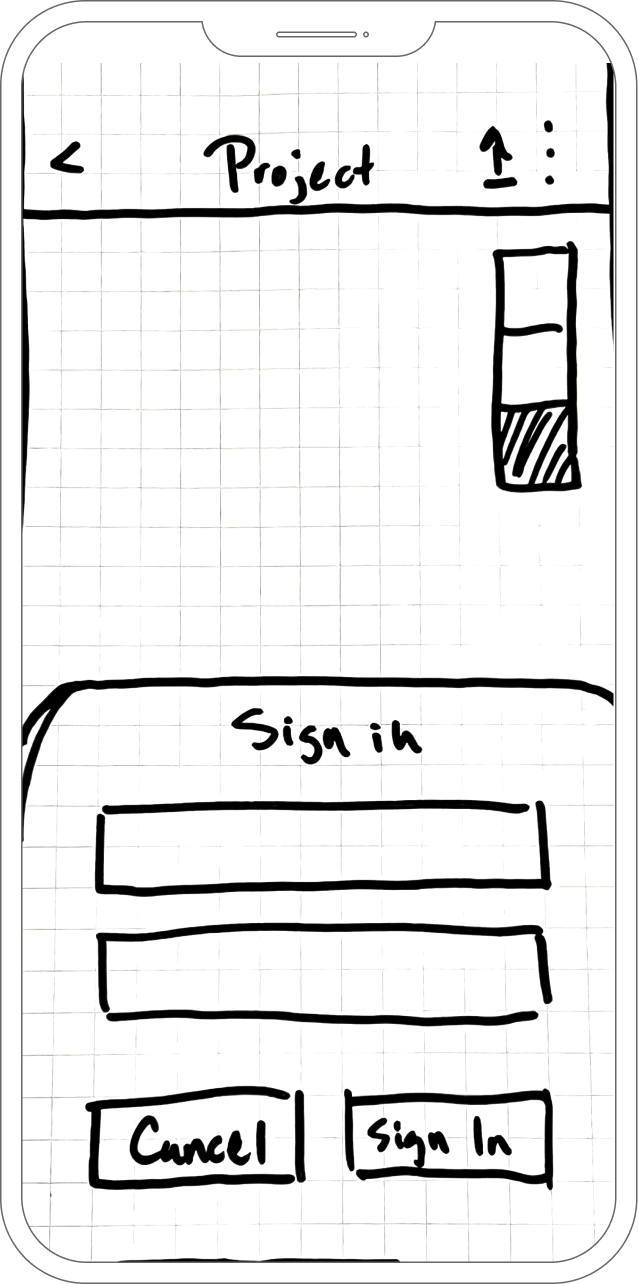
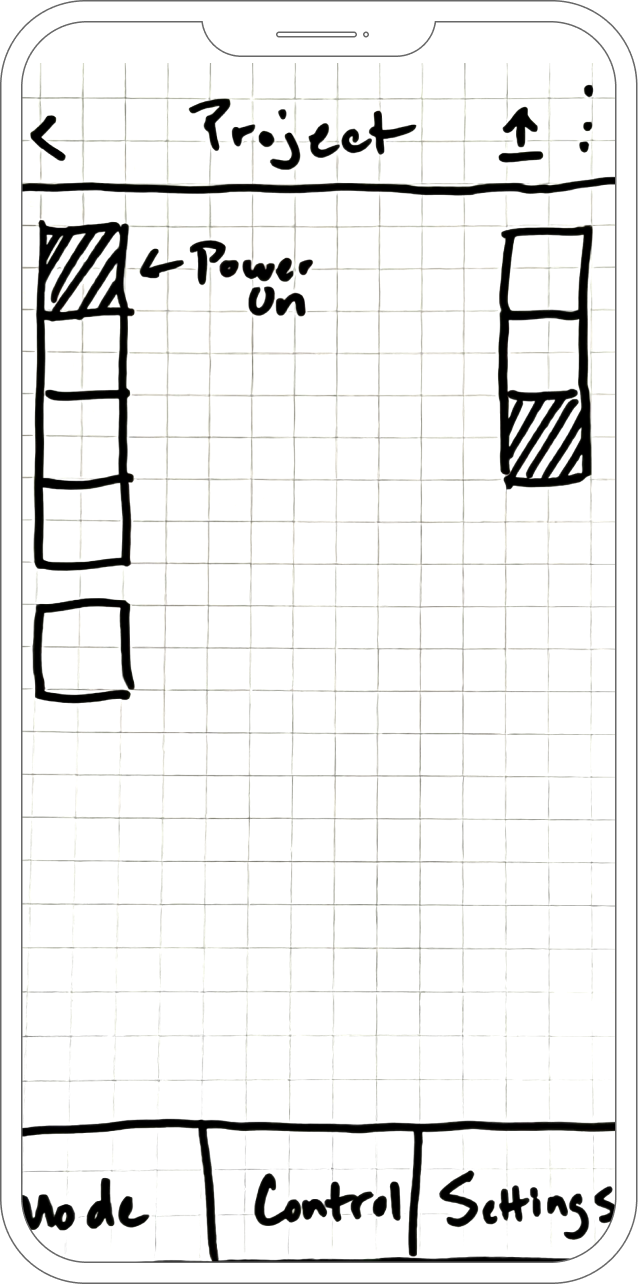
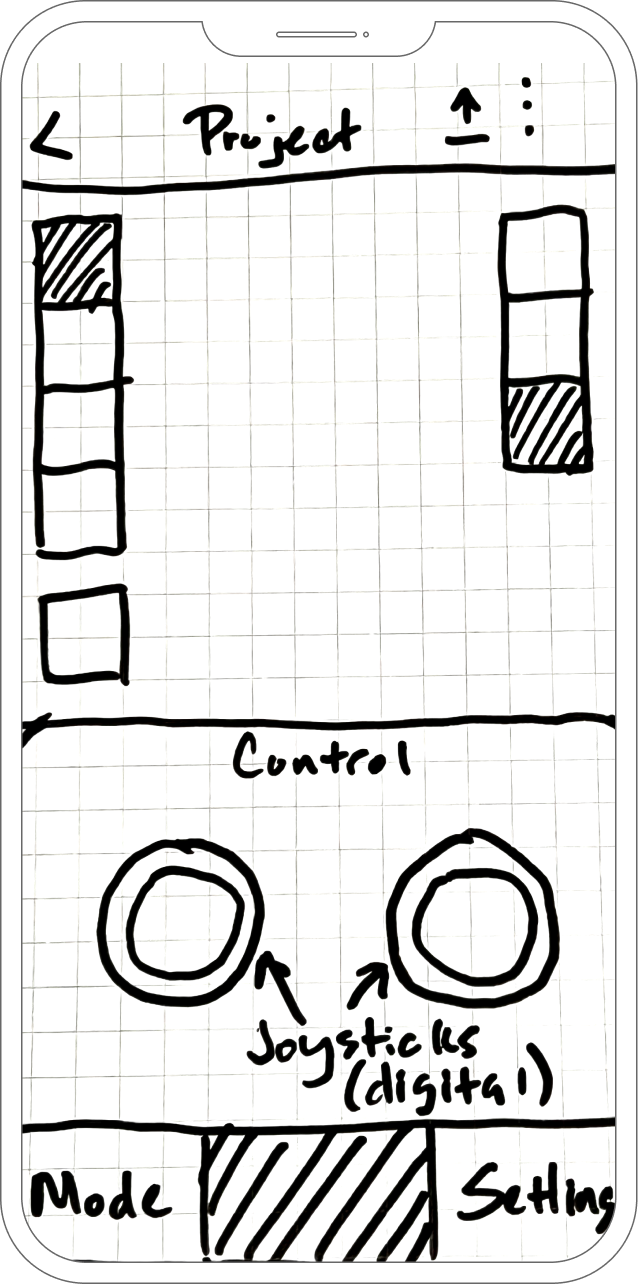
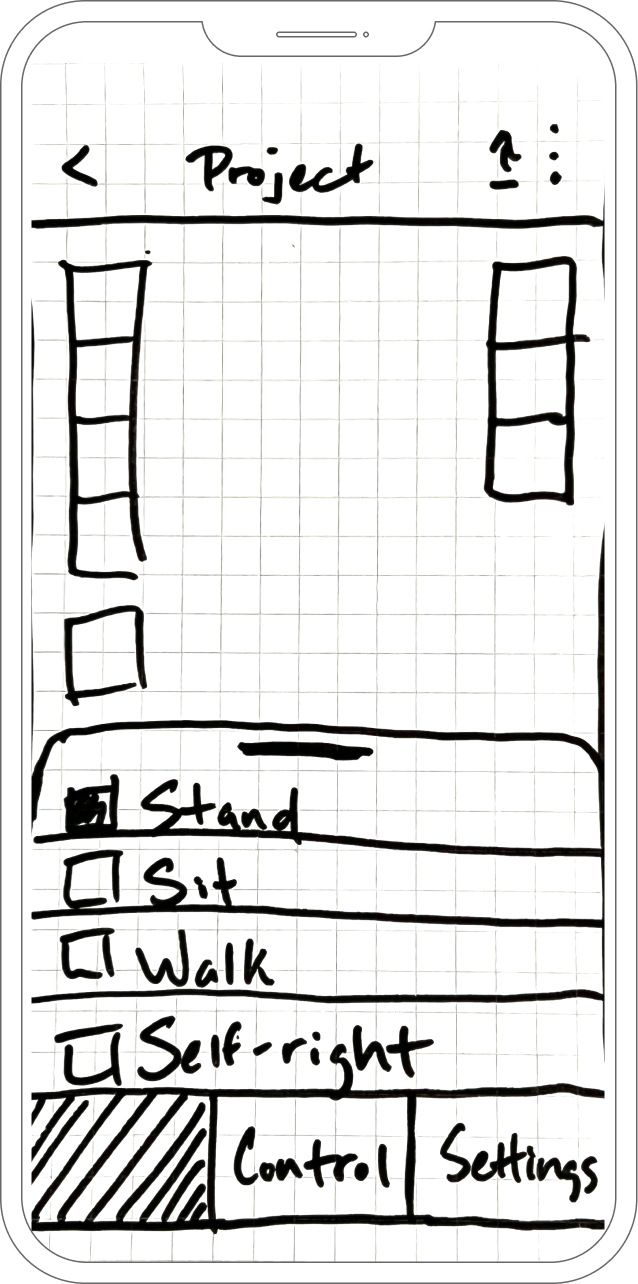
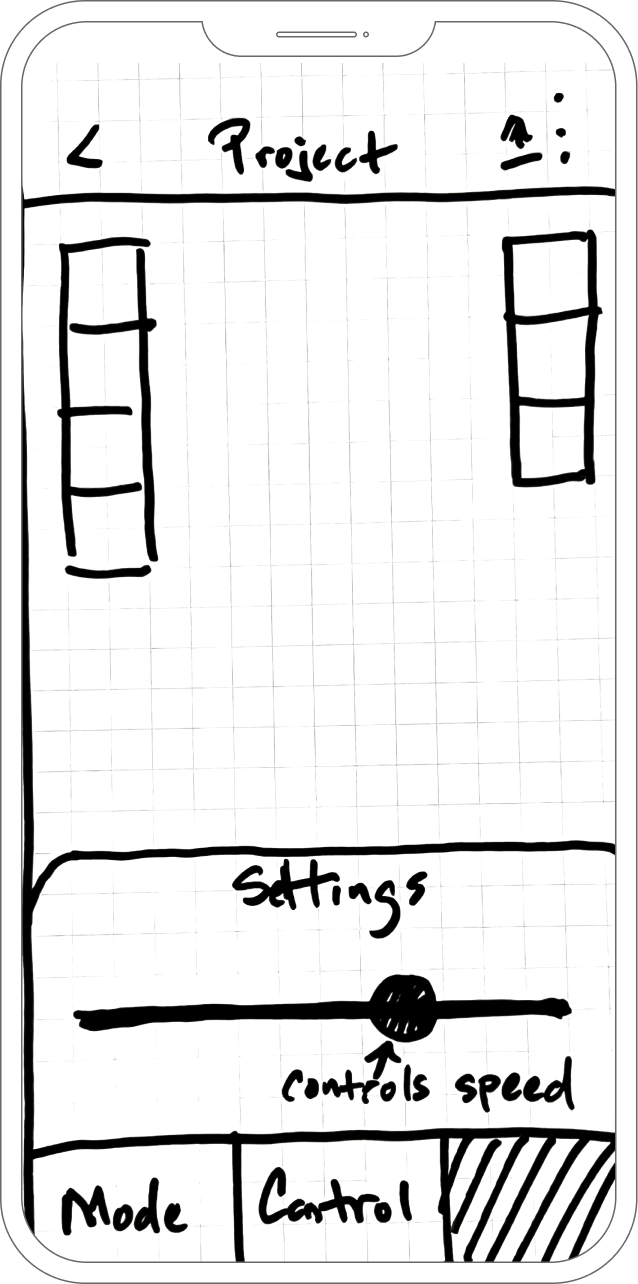
Once I had the main screens prepped, I quickly created some low-fi wireframes of the expanded workflow in Figma to clean things up a bit for the team to begin working on any necessary backend development.
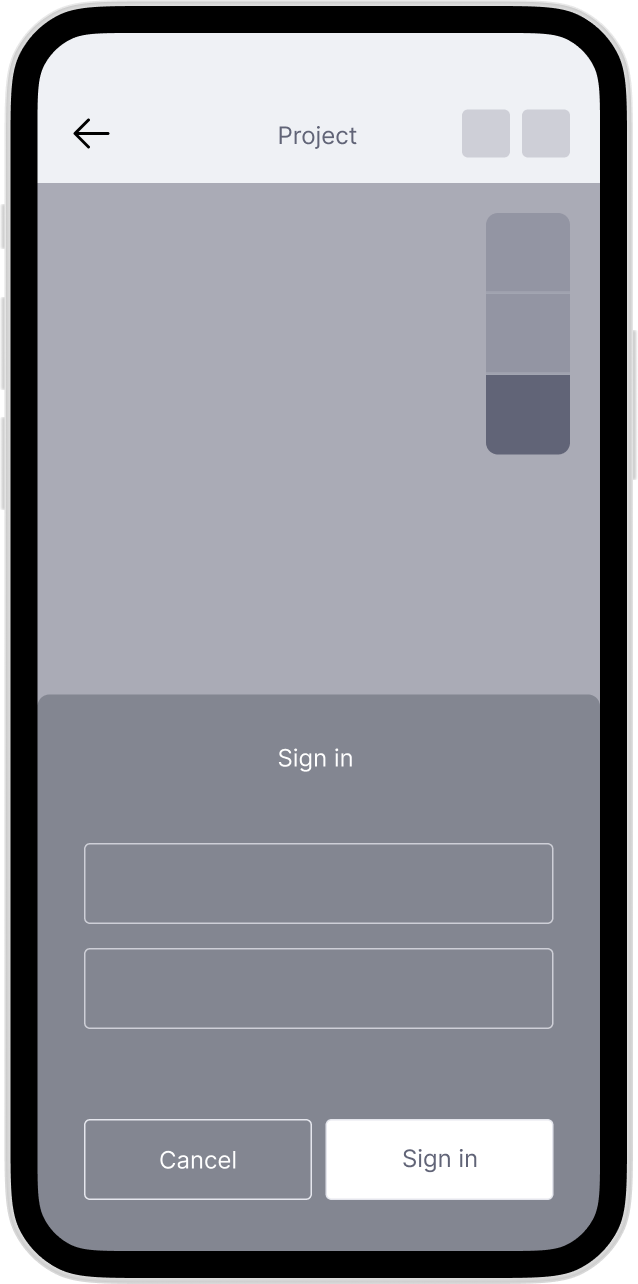
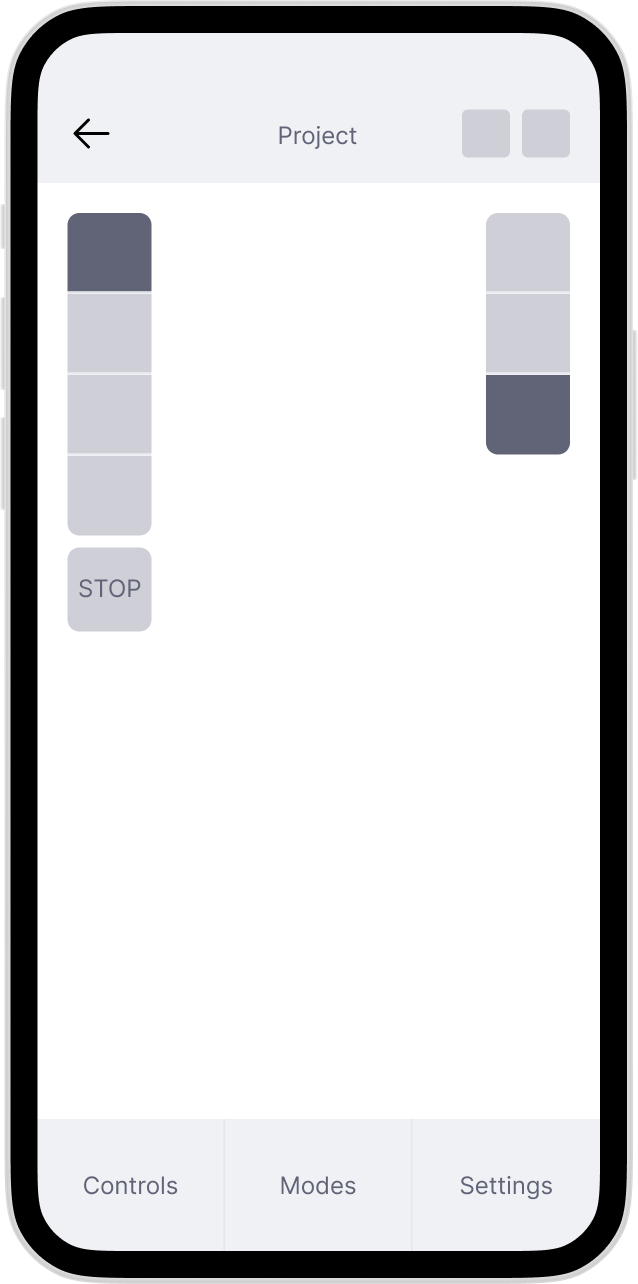
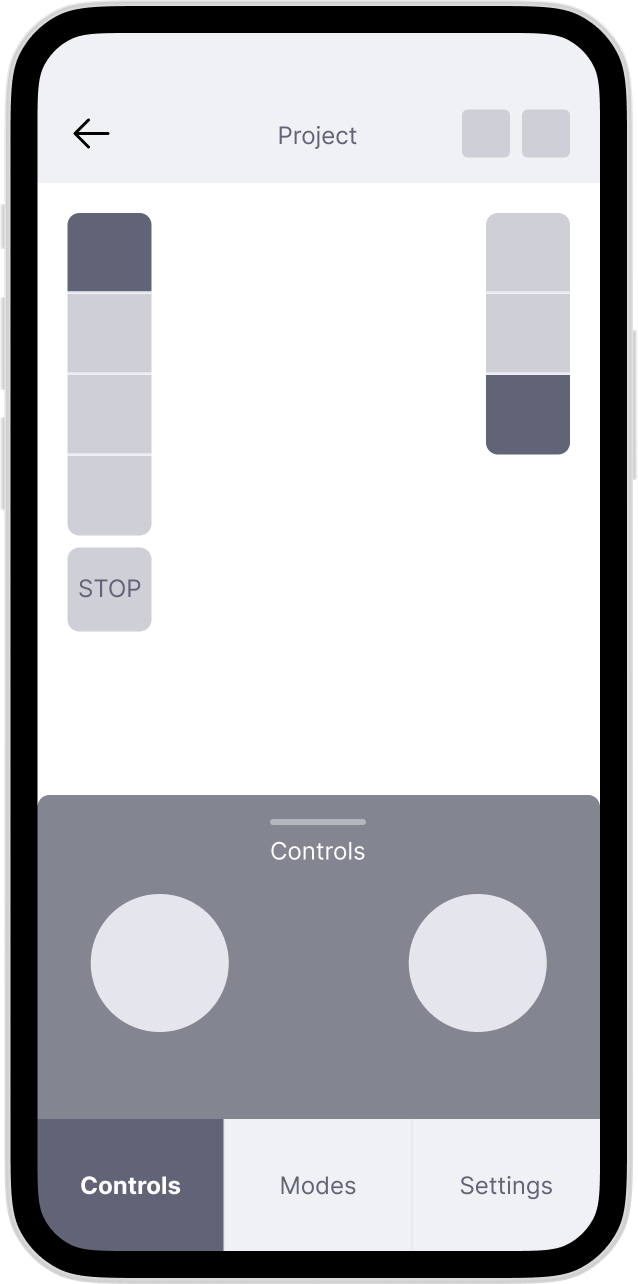
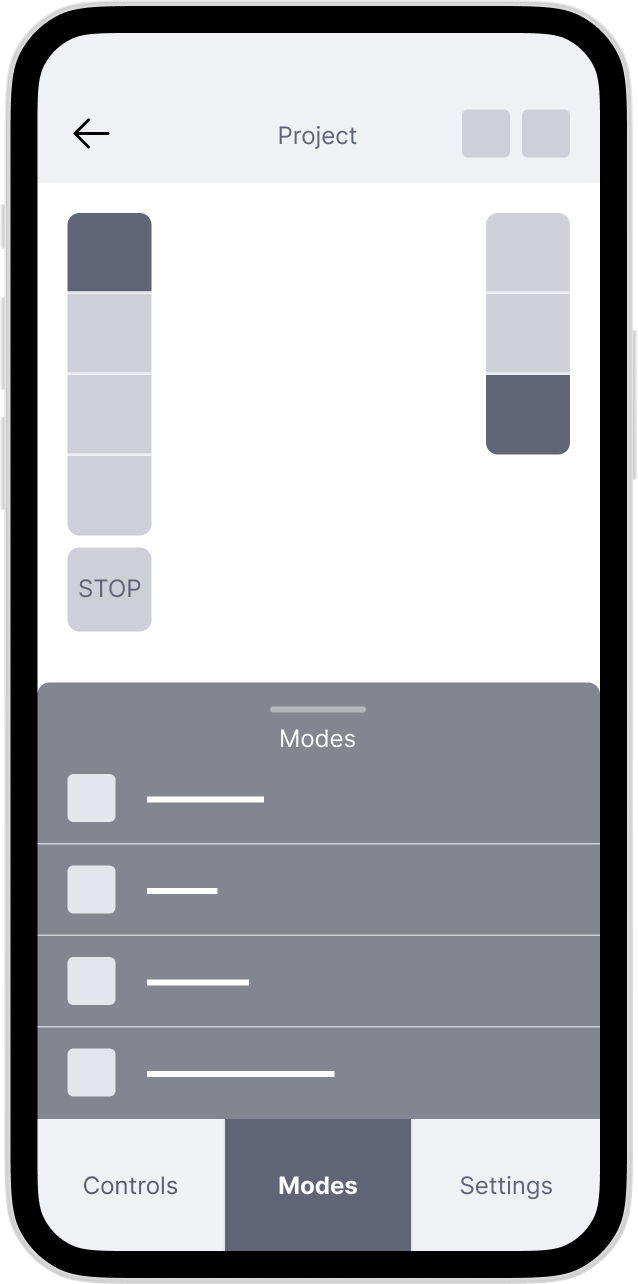
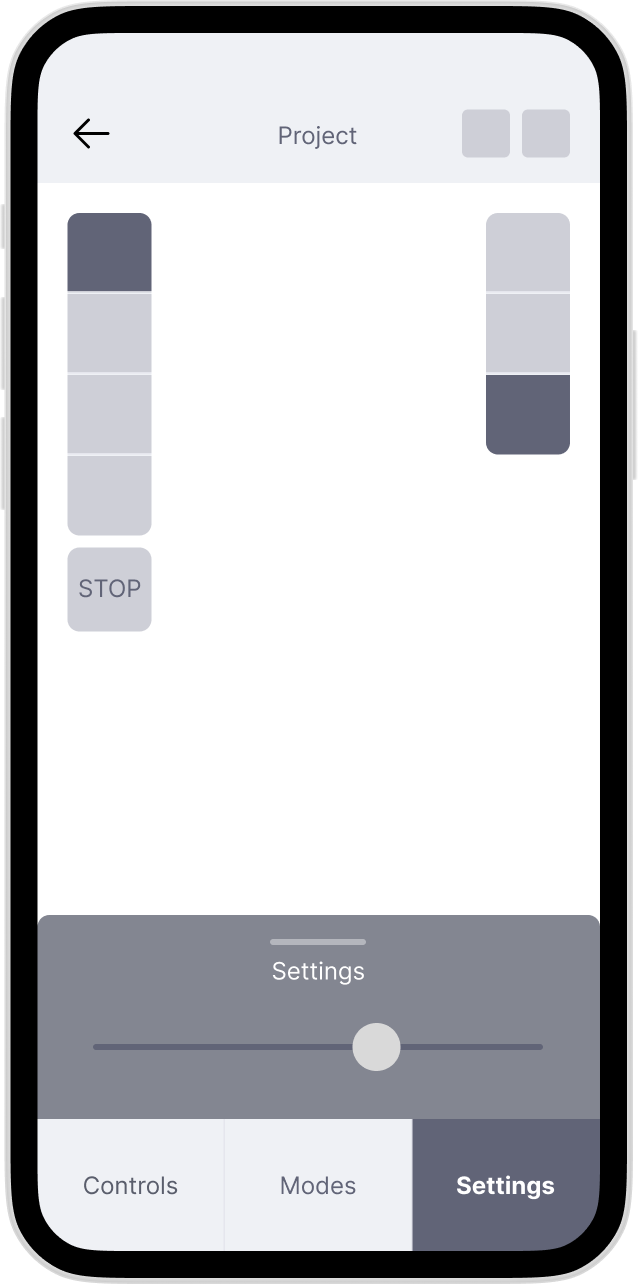
First iteration
After meeting with the team and signing off on the low-fi design concept, I began to work on hi-fi mockups that would provide the team with exact detail for every screen and component needed.
Once complete, I shared the mockups with the dev team in Figma, where they were able to to make some quick suggestions and comments to help swiftly build out the first iteration of our MVP prototype.

Team onsite testing the first prototype of SpotWalk.
Prototyping
Once I finished designing the high fidelity mockups of all necessary screens, I created a simple clickable prototype in Figma to verify all of the interaction details for the MVP prototype that was being built. Considering that we didn't have long to build a functioning prototype, this prototype helped to make implementation as streamlined as possible for our developers.

Tutorial workflow prototype in Figma

Autonomous SpotWalk workflow prototype in Figma
Usability testing
We were fortunate enough to be able to test with 6 users onsite. I presented users with 10 tasks to complete within the SpotWalk workflows as they used the first iteration of our prototype to control Spot around the job site.
Using contextual inquiry, users were able to give us their real time thoughts during testing sessions. This allowed me to dig deeper into specific moments where I could observe apprehension or confusion in the users body language and expressions.
tested with
●
3 Field Engineers
●
2 Supervisors
●
1 Project Manager






key takeaways
●
Users didn’t really understand any of the icons except for Record and struggled to get started when prompted with a task.
●
Most users expected to be able to “set it and forget it” while Spot captures all planned waypoints on the floor plan.
●
Most users were initially confused about how to use the two joysticks together but quickly figured it out.
●
Many people had a false sense of security in the presence of Spot, approaching it like a friendly pet rather than a potentially dangerous piece of machinery.
●
It was asked multiple times if there was a way to schedule multiple walks at once. Repeating the actions to set up a single walk seemed tedious to some.
●
Users need to be lead more into the individual actions that they wanted to achieve.
●
Users need additional context when operating the joystick controls to help maximize safety.
●
Users need to be able to quickly shut down Spot at any given time that it’s in motion.
Implementing feedback
Analyzing feedback from usability tests, I was able to prioritize elements of the experience that would address the greatest needs of our users:
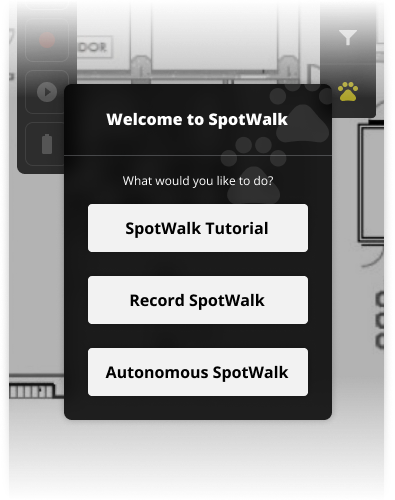
Users needed to be lead more into the individual actions that they wanted to achieve.
how i addressed this need
Adding a start menu lets users explicitly select one of the feature's primary actions, when activated. Upon first use, only the SpotWalk Tutorial option was made available to try and maximize the users' exposure to all key information for using the feature before giving them free reign.
Users need additional context when operating the joystick controls to help maximize safety.
how i addressed this need
Although most users eventually figured this out, I added directional hints on each joystick and an animated help screen to minimize any initial confusion about the functionality.
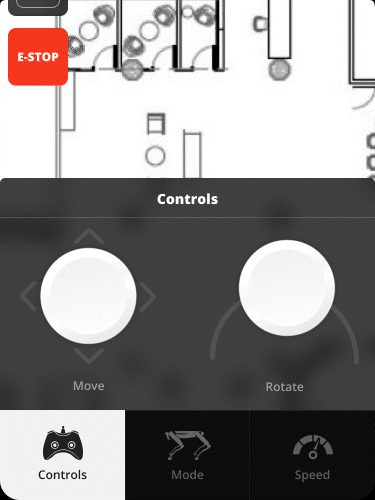
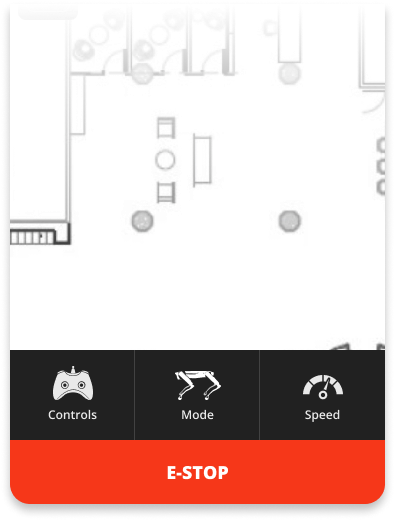
Users need to be able to quickly shut down Spot at any given time that it’s in motion to assure safety.
how i addressed this need
I adjusted the size and position of the Emergency Stop button. This increased the button's accessibility, prominence and touch target, for users that may have gloves on while operating the app.
Validating assumptions
01.
Users need to be able to quickly shut down Spot at any given time that it’s in motion.

6 out of 6 users stated "safety" as a main concern if they were to potentially share the job site with Spot.
02.
Users capture an entire floor plan per walk.
.svg)
3 out of 6 users stated that this would simplify things but acknowledged that this isn't always the reality. Ideally, Spot could capture consecutive floor plans without interference.
03.
Users will not digest large amounts of text-based instruction (more than 4 consecutive screens).

5 out of 6 users became excited and quickly scanned the instructional screens until they were able to access the manual controls for Spot. It was determined that the screens were not fully read due to user actions that the instructions suggested against (ex. maintaining a distance of 6 ft from Spot).
04.
Adoption will be quick.

5 out of 6 users, on average, took about 10 mins to complete the full SpotWalk Tutorial workflow of recording a path and running an autonomous walk. Afterwards, users were able to confidently run both individual workflows with almost no errors. Utilizing a familiar capture workflow, similar to the main app, also helped to speed up understanding of how the new feature worked.
05.
Users will be excited to utilize Spot.

6 out of 6 users were very excited to test out SpotWalk and were very engaged when suggesting improvements or additional functionality for future iterations. However, despite voicing concerns of "safety", users and others passing by could not but help to continuously violate the "6ft rule", due to continued excitement.
04. Final designs
.svg)
"Our efforts have been to create a highly mobile robotics platform that can easily navigate unstructured or unknown environments. HoloBuilder’s SpotWalk app takes this a step further by creating an easy-to-use interface that fits seamlessly into construction workflows. We’re excited to see this integration start rolling out to early customers soon."
— Michael Perry, Vice President of Business Development of Boston Dynamics
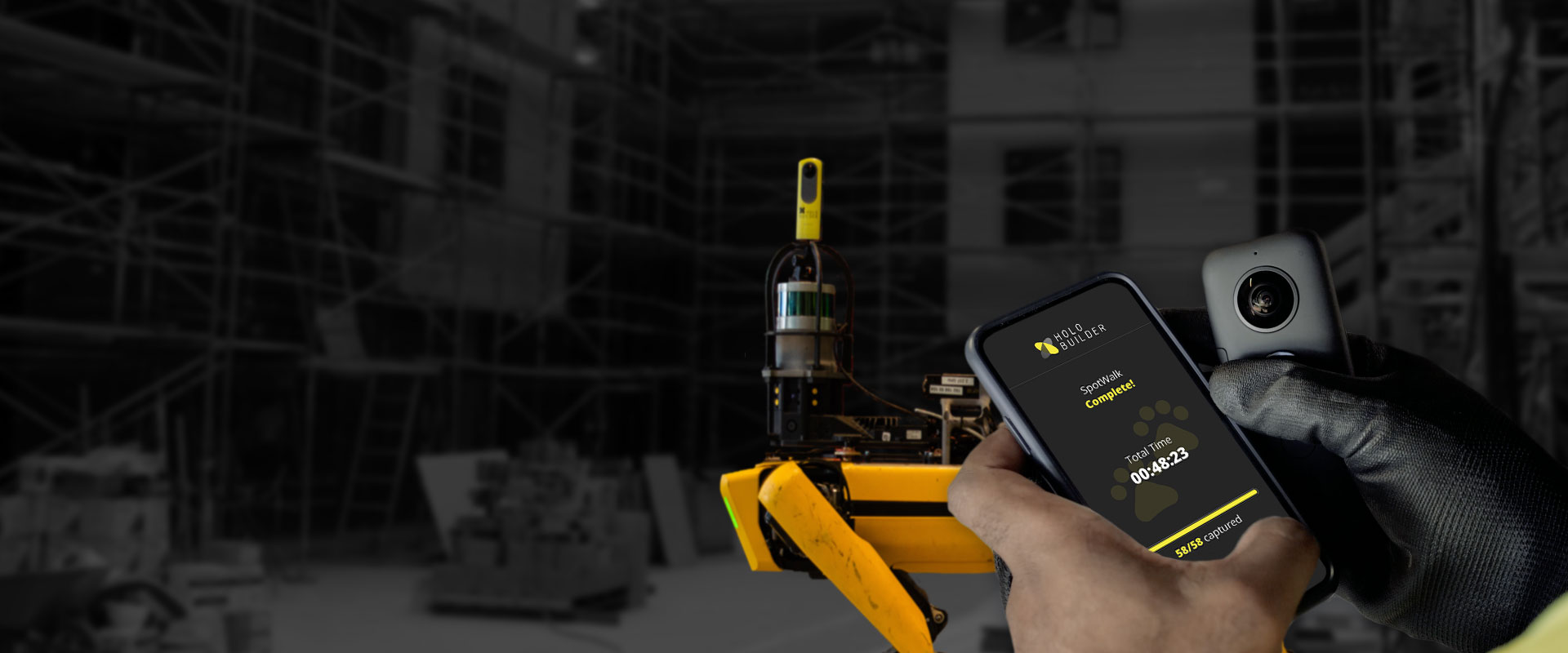
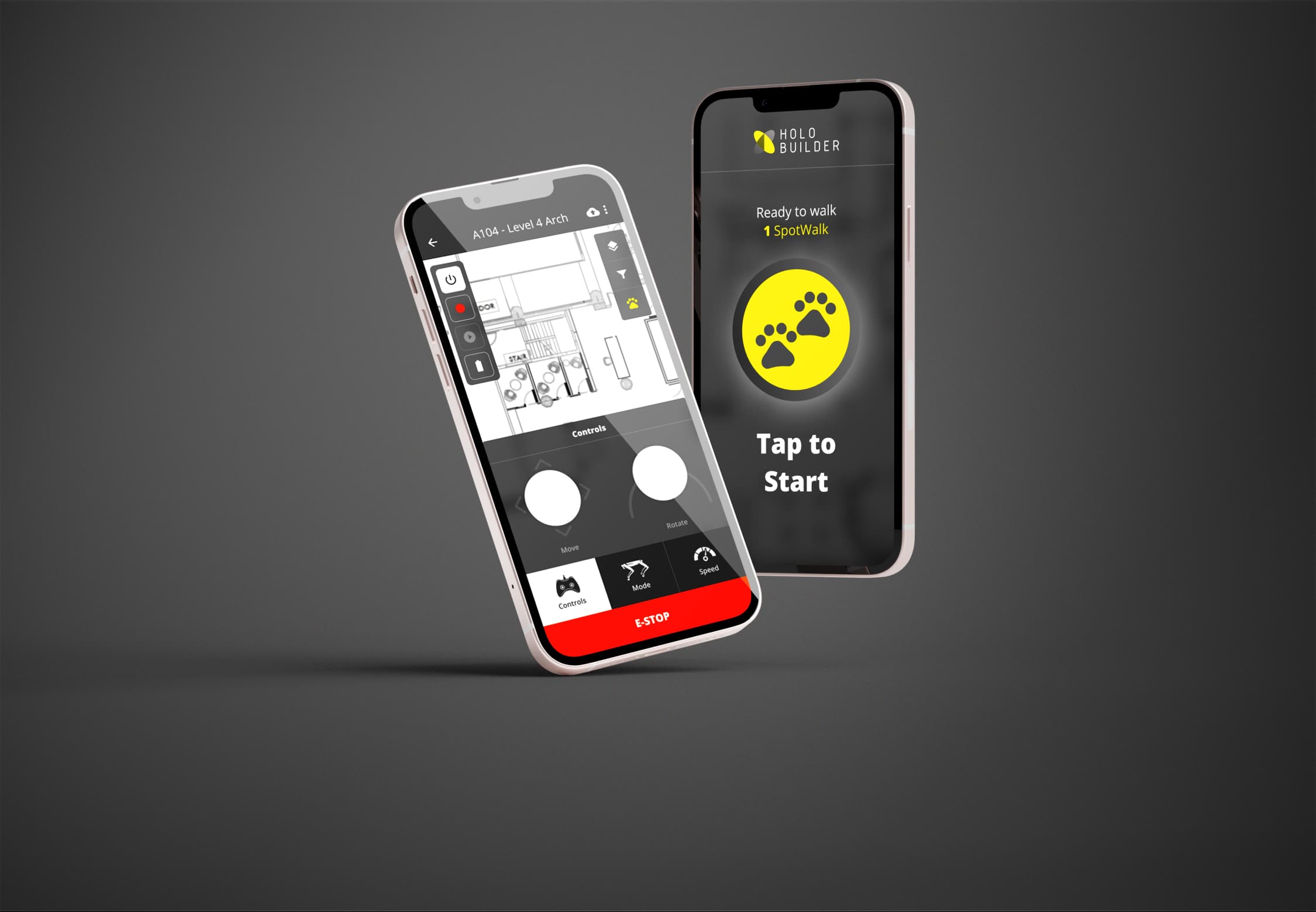
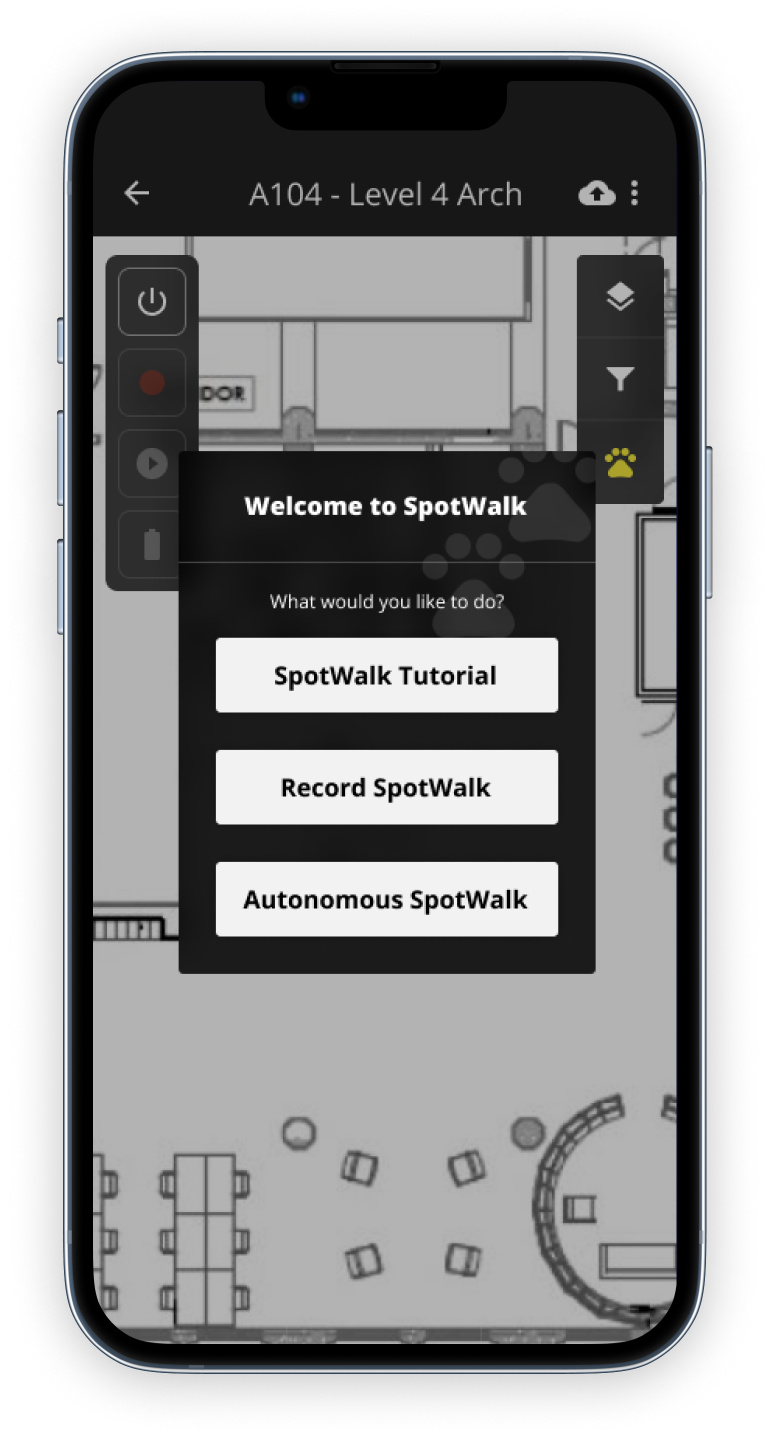
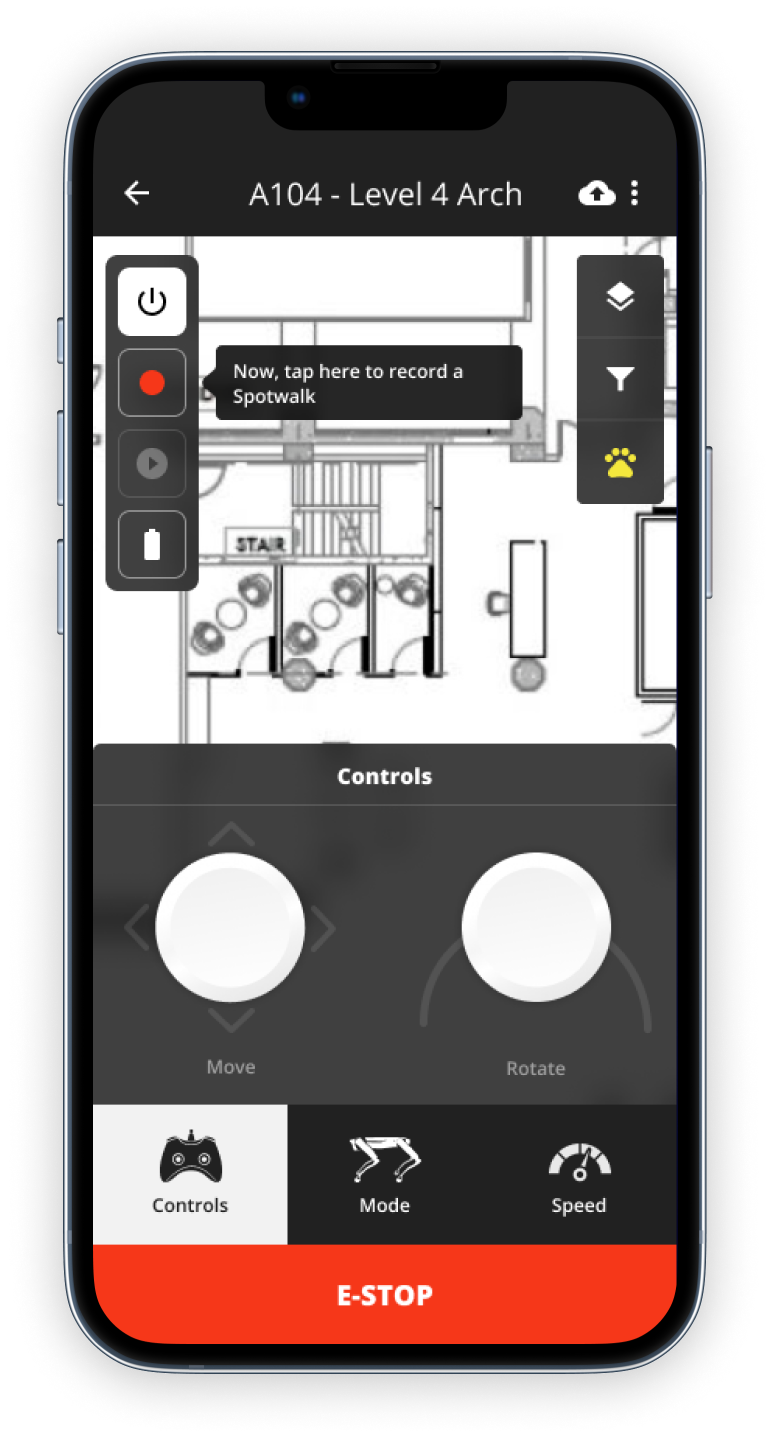

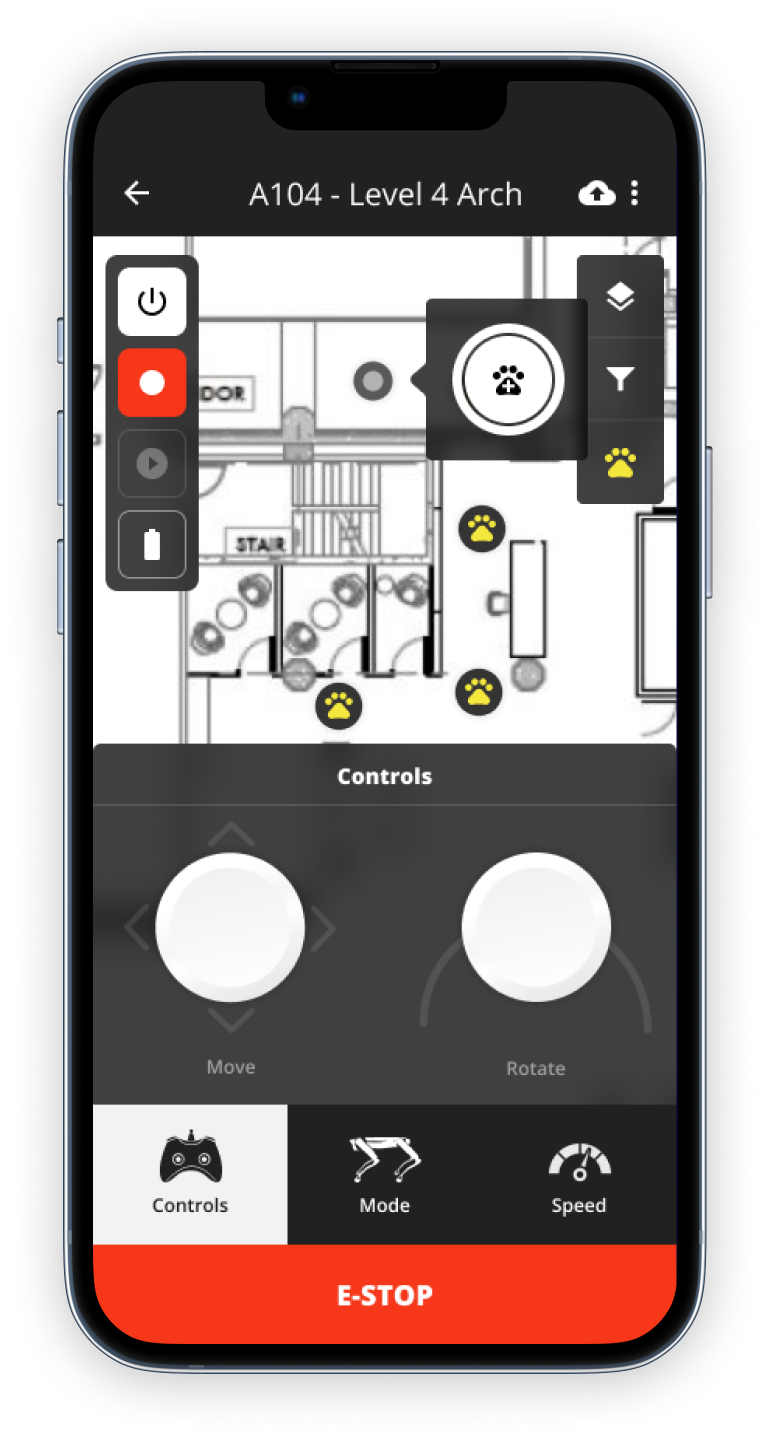
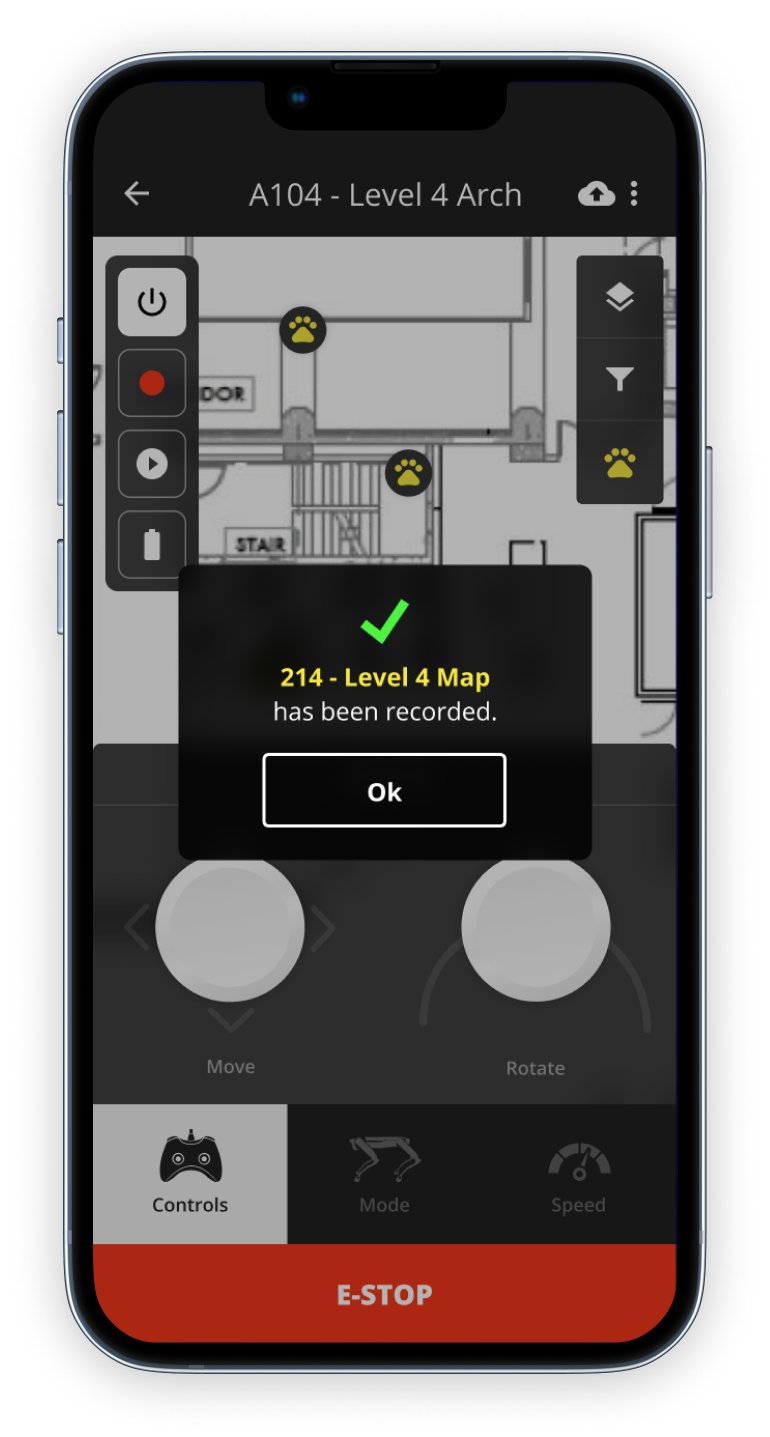
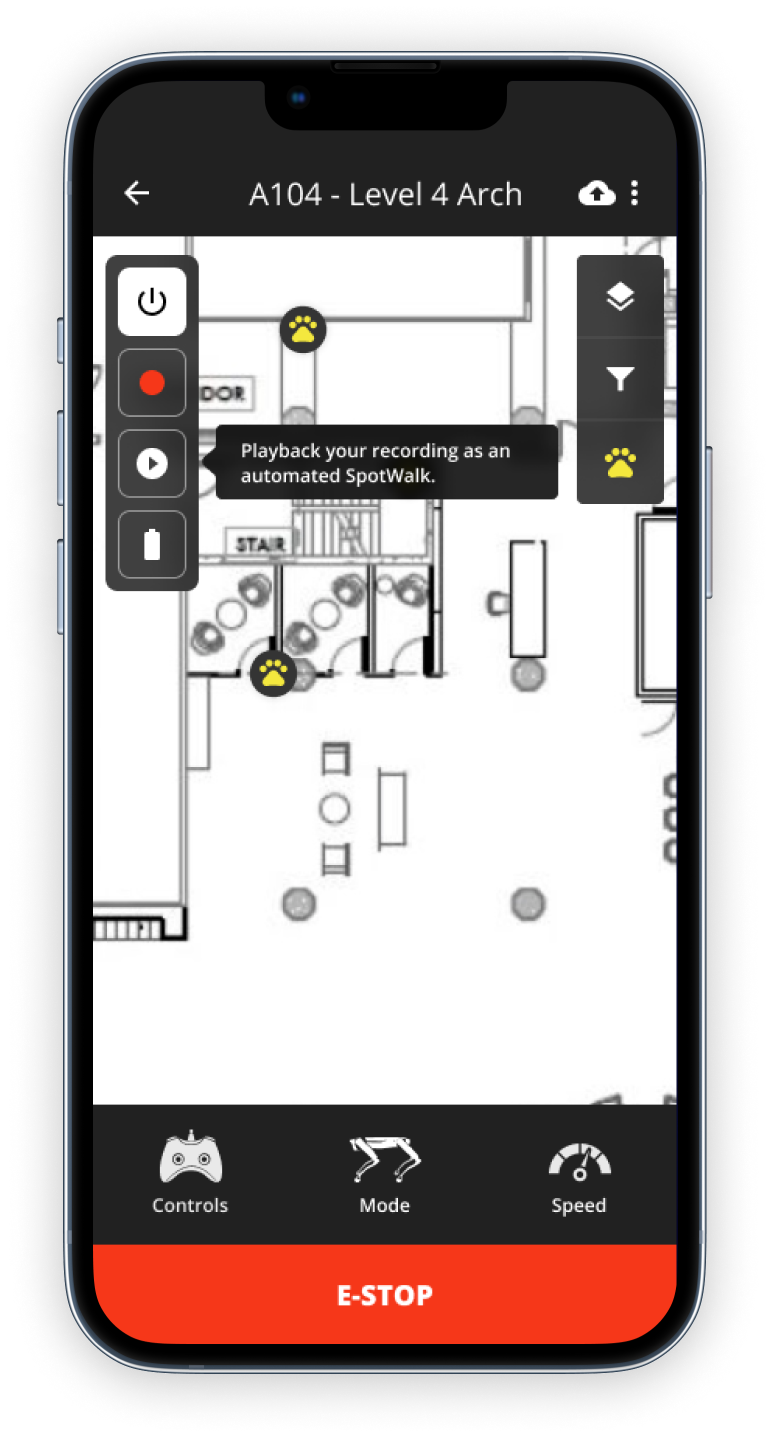
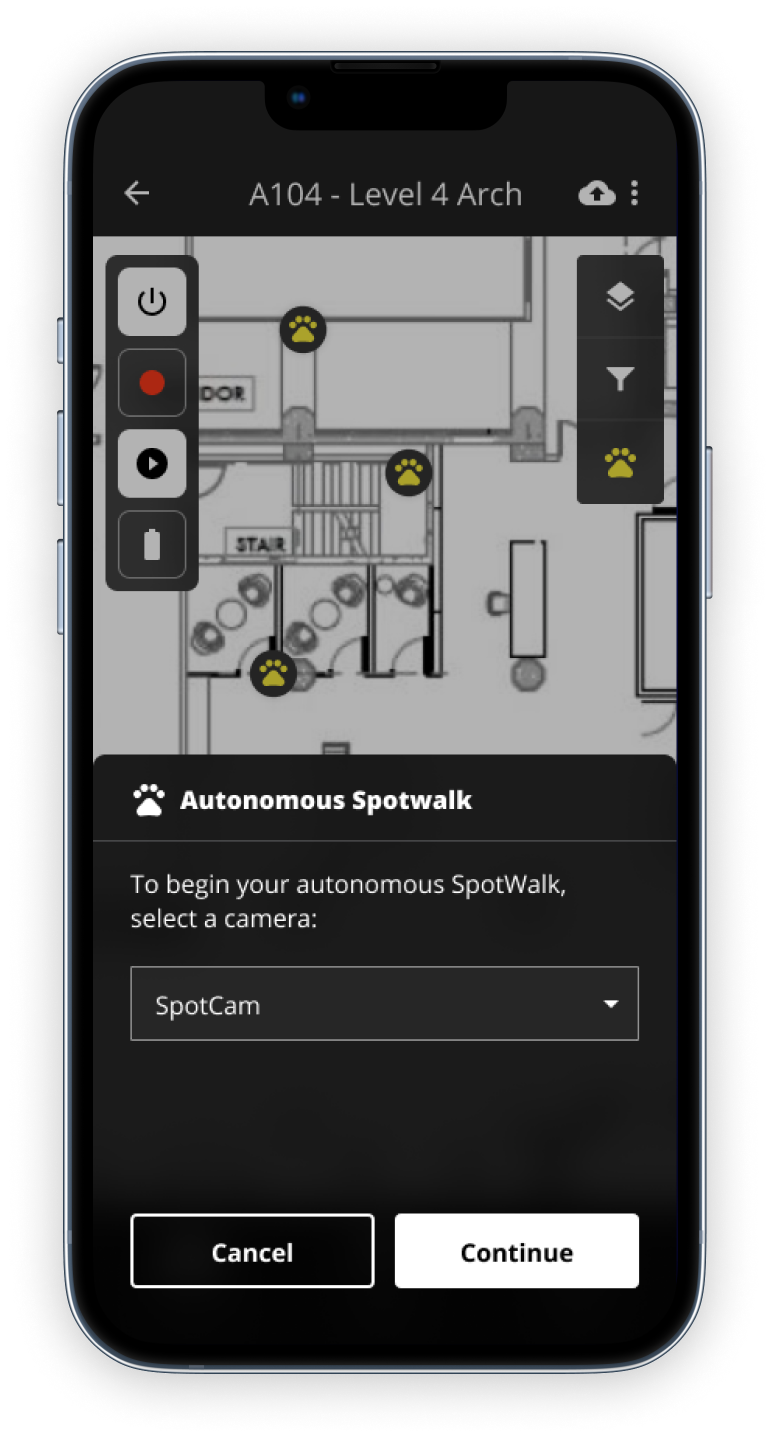
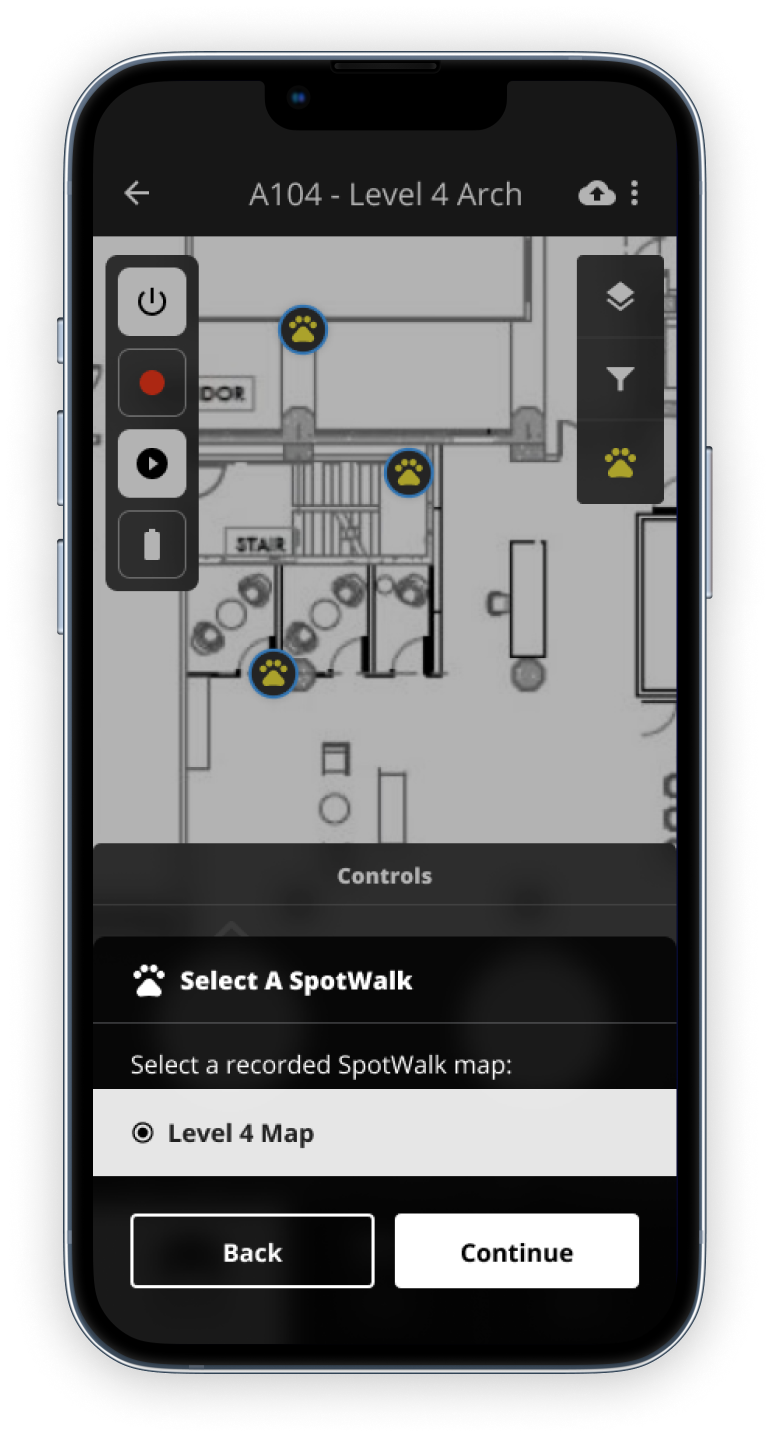

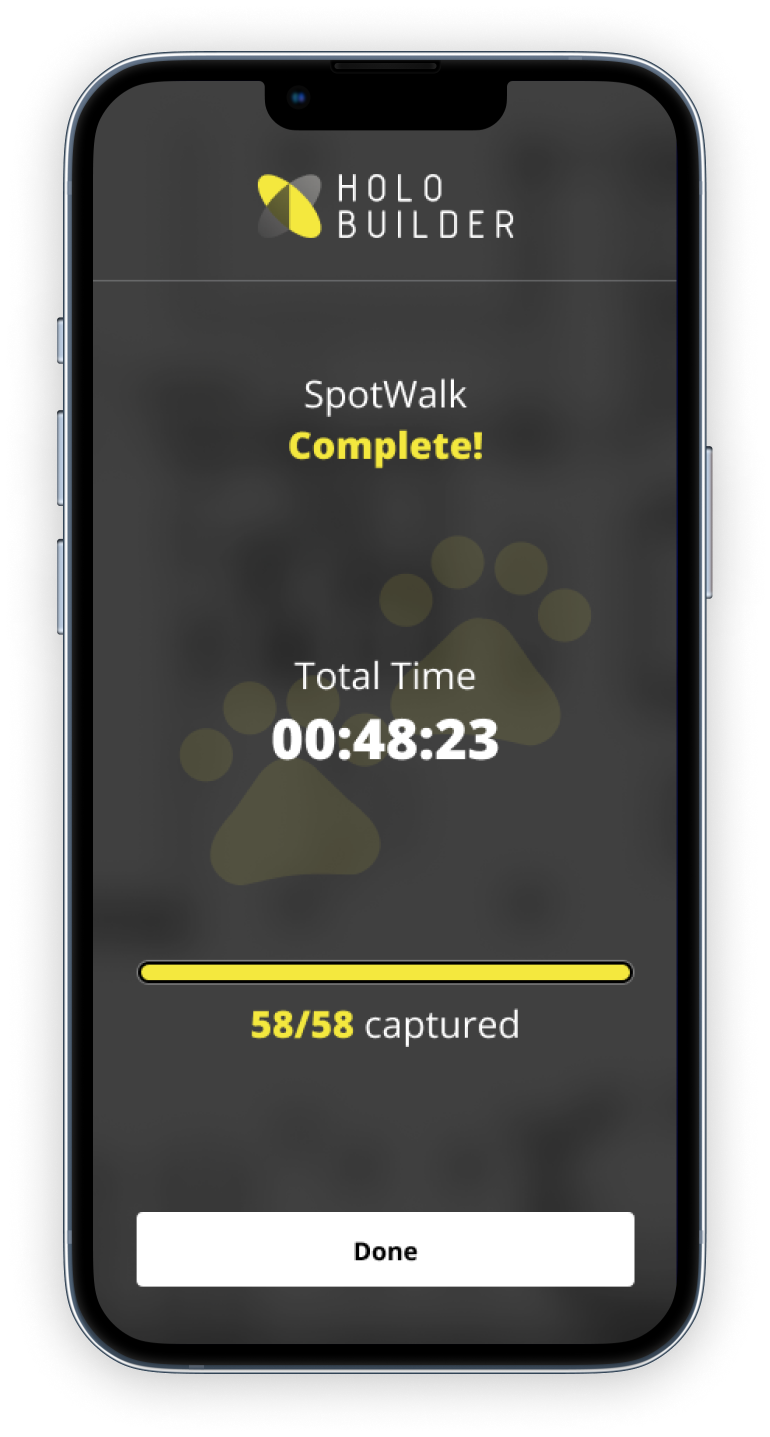
05. Impact
MVP results
Based on usability testing, users were able to cut the amount of active time allocated to photo documentation by 75%, from upwards of 2 hours to an average of 30 mins. Furthermore, Sales was able to close enterprise deals with all customers in the pilot program as a result of this successful integration.
Boston Dynamics used SpotWalk as the basis for its emphasis on user experience when further developing their Spot controller. Boston Dynamics has deployed more than 1,000 Spot quadrupeds in 35+ countries, more quadruped robots deployed in industrial applications than any other vendor.
.svg)
75%
Reduction in time allocated to photo documentation processes.
.svg)
100%
Conversion rate on enterprise deals in the pilot program.
Lessons I learned
plan your approach & execute
Working on this project really helped to put a lot into perspective for me. The quick deadline and ramp up speed required for this project really helped me to understand how important it was to develop a plan and get buy-in from my stakeholders as early as possible.
Next steps
With the MVP rolled out, the team continued to collect feedback from the customers in the pilot program. Unfortunately, I did not have the bandwidth to continue monitoring the project but I'd have loved to continue tracking usage and iterating to make the experience as seamless as possible by measuring metrics like error rate and customer satisfaction score (CSAT) on a larger scale.
While we weren't able to implement all of the features and functionality that we would've liked, we still created epics for them in JIRA for future iterations of the integration. Some other features that were brainstormed for the next iteration were:
●
Scheduling - allow Spot to schedule and queue multiple paths to walk consecutively.
●
Voice command - user controls spot with vocal commands.
●
Offsite control - support control of Spot from offsite.